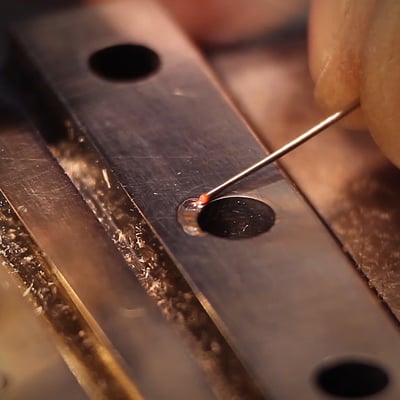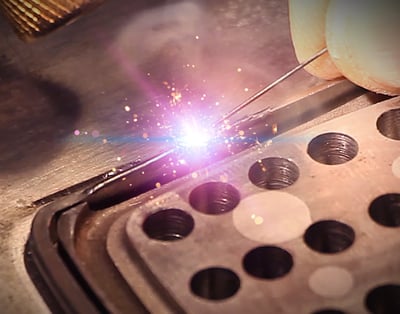.jpeg?width=1200&height=675&name=Mold%20Repair%20Welding%20Image%20(1).jpeg) Today’s small precision welding shops specializing in plastic injection mold, dies and tooling repair have a wide range of new technologies available to enhance their ability to provide the highest level of quality, craftsmanship, and service to their clients. One of the fastest growing technologies is the use of manual micro-welding laser systems as an alternative to traditional microscope GTA welding.
Today’s small precision welding shops specializing in plastic injection mold, dies and tooling repair have a wide range of new technologies available to enhance their ability to provide the highest level of quality, craftsmanship, and service to their clients. One of the fastest growing technologies is the use of manual micro-welding laser systems as an alternative to traditional microscope GTA welding.
Quick Links
- What is Laser Welding?
- What is Mold Repair?
- Who is Choosing Laser Welding for Mold Repair: A Brief Case Study
- Why Choose LaserStar Welders for Mold Repair
What is Laser Welding?
Laser welding is an advanced welding technique that uses a highly focused, narrow laser beam to generate intense levels of heat in very small areas to melt the materials being welded together. The high intensity of the laser beam allows for extremely precise control, making it possible to join very small or intricate parts with extremely consistent results. As a result, laser welding is used in industries and fields that require precision such as automotive, aerospace, and medical device.
More specifically, laser welding provides extreme precision and accuracy when compared to traditional methods; its ability to penetrate deep into hard-to-reach areas; its cost effectiveness relative to other processes; as well as its negligible effect on nearby structures or components due to limited heat input, make it the superior choice for the above industries and more.
Additionally, this method can also help reduce labor costs associated with manual welding by eliminating most user preparation processes such as grinding and preheating prior to joining pieces together—a major advantage over traditional techniques like arc welding and spot welding.
 What is Mold Repair?
What is Mold Repair?
Mold repair is the process of addressing damages to a mold that has been used in industrial settings. Repair can include modifications and adjustments to the shape, size, or condition of a mold cavity. Mold repair can be complex, requiring the use of a variety of repair methods including grinding, machining, welding, and more. In some cases, multiple methods may need to be employed in order to restore the tool to its original condition.
Industrial molds are often made of metal, such as steel or aluminum, and designed for injection molding so that parts can be created through a variety of plastic processes. Poor maintenance and inadequate design can lead to damage and deformation of the tool after repetitive use. In addition to regular maintenance and inspection, an industrial mold may need repair due to extreme temperatures or stresses from overuse or poor part ejection from the tool cavity.
When a tool needs repair, many factors must be considered including material integrity and dimensional accuracy of the part being produced as well as any unique characteristics of its production environment. The goal is typically restoring the tool's original design parameters while preserving the quality of parts produced with it. This, as you can imagine, requires precision, accuracy, and, in many cases, heat control, which means it’s perfect for laser application.
Who is Choosing Laser Welding for Mold Repair: A Brief Case Study
Laser welding is ideal for modifications and repairs on molds, tools and dies whether due to damage, wear and tear, or a change in workpiece design. The process is quick, precise and will not damage surrounding surfaces. As a result, Tool and Die shops currently using laser welding systems are often amazed at the wide range of applications and ability to produce a higher quality product in less time with fewer materials while eliminating excessive heat effects.
Take Wicked Welding Inc. in Dayton, OH who was looking to invest in a reliable laser welding solution to improve and enhance the services available to their industrial clients.
According to their President, Pete Mourouzis, “Just 6 months after purchasing our manual laser welder, it accounts for approximately 30% of sales. Crossover from microscope GTA welding was easy and fast. Just two days after receiving our LaserStar Laser Welding Workstation it was operational and we had repaired our first mold. I’m confident of a very quick pay-back.”
Wicked Welding specializes in laser welding and prides itself on the work they’re able to produce using a laser welding system purchased from LaserStar.
One of the key elements in making manual laser welding applicable to Tool and Die or Mold manufacturing and repair was the development of the “free-moving” concept. With this approach, the laser generates a stationary infrared light pulse which is targeted through the microscope’s crosshair. The laser pulse can be controlled in both size and intensity. Because the heat generated remains localized, operators can handle or fixture items with their fingers, laser welding small areas with pin-point accuracy, all without causing any harm to the operator’s fingers or hands. This free-moving concept enables users to eliminate costly fixturing devices and increase the range of assembly and repair applications.
As a result, companies improve safety while improving their products and services, and delivering both consistently and quickly. And, as Wicked Welding demonstrates, you get great ROI, and quickly!
 Why Choose LaserStar Welders for Mold Repair
Why Choose LaserStar Welders for Mold Repair
Mold repair requires precision, accuracy, and attention to detail. It requires an understanding of the laser welding process and how to leverage the tools you have to get the results you want. That also requires unparalleled customer service and support, a hallmark of LaserStar’s business.
We know our machines and a sale isn’t the end of our relationship, for many, it’s just the start as we provide ongoing support and training. In addition to this support, LaserStar micro welding laser systems are ideal for a wide range of large plastic injection mold, tool & die maintenance and repair applications. Some benefits include:
- Lay a bead as small as .0025” / 0.05mm
- Repair slots, pockets, radius contours and angles
- Repair polished, textured and engraved surfaces
- Repair thin walls with little or no warping
- Repair parting line edges and heat sensitive areas
- Alloys include tool steel, aluminum, copper, titanium and powdered metals
LaserStar micro welding laser systems produce a high quality result, reduce the hand work required before polishing, and practically eliminate sink lines. Whether you’re looking to improve your existing repair work or add laser welding to your services, we’d love to talk.
Get in touch with the team at LaserStar and let’s get growing…and welding.

